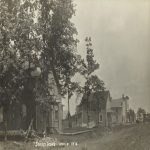Although Sheboygan and Milwaukee are only 55 minutes apart by car today, the two cities on the west coast of Lake Michigan remained largely separate in 1900 when they competed with each other to become the industrial capital of Wisconsin. Through the latter half of the 19th century and the first half of the 20th century, the industrialization process in both cities was shaped by an increase in Jewish immigration to the region.

Starting in the 1840s, German Jews made up the first group of Jewish immigrants to Wisconsin, settling almost exclusively in Milwaukee. Wisconsin’s Jewish population remained relatively small until the last two decades of the 19th century. In 1880, 2,559 Jews lived in Wisconsin. Just nine years later, 10,000 Jews lived in Wisconsin, mostly in Milwaukee. With this rapid increase in the Jewish population, Jews began increasingly contributing to the industrialization of their new home. By 1895, the growing German Jewish community owned nearly all the clothing factories in the city.
While the larger Milwaukee Jewish community started to flourish by the turn of the century, smaller Jewish communities across the state were just starting to grow. In Sheboygan, the Jewish community was made up primarily of immigrants from Eastern Europe and Russia. Unlike earlier Jewish immigrants, these groups were deliberately moved away from New York City and other large metropolitan areas on the East Coast.
The Industrial Removal Office, a non-governmental organization headquartered in New York City and established by German Jews, worked to move new Jewish immigrants to the United States away from New York City to smaller cities all across the internal and western United States. They were afraid that if too many Jews lived in New York City, antisemitism would destabilize their already established community. In Wisconsin, the Industrial Removal Office moved Eastern European Jews to Beloit, Racine, LaCrosse, and Sheboygan. Jewish settlement in Sheboygan expanded rapidly as a tight group of mostly Orthodox Russian Jews formed. The first Russian Jews to settle in the city created a manufacturing infrastructure which provided opportunities for other Jews relocated to the area.
Herman J. Holman arrived in Sheboygan from Eastern Europe in 1890 and became a central figure in both Sheboygan manufacturing and the emerging Jewish community. He created three different businesses: the Holman Overall Company, Lakeland Manufacturing, and the Reliable Shirt and Overall Company. Holman not only worked as a leading businessman in the community but he also served as the president of Sheboygan’s first conservative synagogue, Congregation Beth El.
According to a newspaper article from the Sheboygan Press in 1942, the Lakeland Manufacturing Company expanded steadily in Sheboygan, changing plant locations and operating sizes in 1919 and 1925. The company specialized in mostly men’s and boy’s outdoors wear, manufacturing leather jackets, wool fingertips, mackinaws, leisure coats, and snowsuits. By the 1940s, the Lakeland Manufacturing Company shipped their products throughout the United States. In 1942, the company employed 250 people. This period marked a high point for both Jewish life and manufacturing in Sheboygan.
Today, Sheboygan’s Jewish population has shrunk as many of the children and grandchildren of the original immigrants moved to cities with larger Jewish communities. There is only one conservative synagogue left in Sheboygan, and it has so few members that it can no longer support a rabbi.
Written by Jack Styler, July 2020.
SOURCES
“Jews in Wisconsin.” Wisconsin Historical Society. Wisconsin Historical Society, August 3, 2012. https://www.wisconsinhistory.org/Records/Article/CS1872.
Rockaway, Robert. “How the Industrial Removal Office Sent Jews to America’s Heartland.” Tablet Magazine. May 16, 2018. Accessed June 18, 2020. https://www.tabletmag.com/sections/news/articles/industrial-removal-office.
“The AJHS Manuscript Catalog — Industrial Removal Office.” JewishGen.com. Accessed June 8, 2020.
Alpert, Joel. “Sheboygan, Wisconsin.” Jewishgen.org. Accessed May 26, 2020. https://kehilalinks.jewishgen.org/Sheboygan/Sheboygan.html
Zander, Sherry. “Bratwurst Meets Borscht.” Smallsynogogues.com. Accessed May 26, 2020. https://smallsynagogues.com/sheboygan.htm
“Lakeland Manufacturing Co. is Making Excellent Strides.” Sheboygan Press. (Sheboygan, WI), July 31, 1942.





